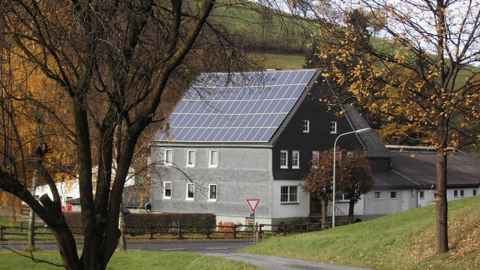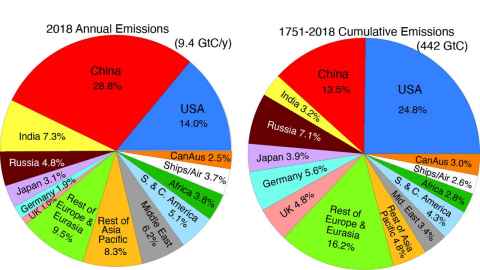NZ should cut emissions, not buy overseas offsets
17 November 2021
Opinion: Centralised control of New Zealand's hydro, solar and wind power and storage is the only way to reduce energy emissions, Kevin Trenberth argues.

Climate change is happening, mostly due to human activities resulting in changed atmospheric composition that interferes with the natural flow of energy through the climate system. Two greenhouse gases contribute most to this problem, carbon dioxide and methane; emissions of both could be reduced significantly.
Carbon dioxide has increased by 48 percent since the 1800s. As a result, there is global heating: rising temperatures, increased drying, more atmospheric moisture, heavier rains, stronger storms, and more intense droughts, heatwaves, and wildfires.
A price on carbon that most companies do not currently pay, created through a tax or carbon market system, would capture the cost of harms caused by greenhouse gas emissions. Indeed, New Zealand has an Emissions Trading Scheme although it does not include agriculture. Prospects for such a price are particularly critical for power production and energy-intensive industries.
A few days before COP26, James Shaw, Minister of Climate Change and Associate Minister for the Environment (Biodiversity) announced New Zealand had raised the pledge to cut greenhouse gas emissions to 50 percent of 2005 levels by 2030.
But only about a third of the pledged cuts will come from within the country. The rest would be purchased as carbon credits from offshore mitigation, which could cost billions of dollars. What’s more, there is no system for doing this, or for ensuring cuts are genuine. Further, forests that take up carbon do not last forever, and a forest fire can wipe out all offsets!
The Climate Change Response (Zero Carbon) Amendment Act 2019 requires greenhouse gas emissions (other than biogenic methane) to reach net zero by 2050. The act also established the Climate Change Commission and an emissions reduction plan for 2022-2025.
Recommendations centred around rapid adoption of electric vehicles but without plans for where the extra electricity would come from; and plans for phase-out of coal-fired power and energy for drying milk (Fonterra) are much too slow to meet goals of the Paris Agreement. Other key issues include transmission of power from where it is generated to where it is needed, and how to store energy cheaply.
The answer to the source of power must be solar and wind, although bio (wood) waste can also contribute, but neither the Climate Commission nor the Government’s Emissions Reduction Plan address these issues. This is not commercial solar and wind farms so much as rooftop solar, and even wind.
In Germany, with about 20 percent less sunshine than New Zealand, 1.3 million homes (3 percent) have solar power, generating 4,900 MW of power (8.2 percent of their total). Here, there is an estimated 68 MW from some 19,500 homes (1 percent), and all solar (not just rooftop) provides just 0.5 percent of New Zealand’s power. A major reason for the very low uptake of solar is the absence of incentives; instead there are penalties, detailed below.
In many countries “net metering” is in place. That is, extra power not used from rooftop solar at the site is sent to the power company and then recovered later when needed, at no cost.
Instead, in New Zealand, the cost of buying the power back is a lot higher; typically, power is purchased from the homeowner at $0.08 per KWh and sold back at about $0.28 per KWh. Moreover, the companies discourage use of solar power. These are major disincentives to install solar. The government should immediately stop this practice.

Both solar power and wind power are intermittent. The sun does not shine at night! The problem for the power company is there will be times when it has too much power compared to demand, and managing this intermittency is an unwanted challenge.
This problem is exacerbated by a plethora of small electric companies but would be greatly reduced if they were all to share in some way. The best way to deal with this issue is to couple wind and solar power to hydro power, and simply save the water from flowing over the dam and driving turbines. The bigger the system, the more likely there is to be compensation available. The challenge then is how to best integrate these sources of power into a national system.
Because sunshine is most abundant when wind is less and rain for hydro is also less, there is a natural compensation. Wind is somewhat capricious and may be blowing hard at one spot, but not much nearby. It is well established that assembling a large array of wind generators reduces the intermittency factor.
But what happens when there is excess power? How can it be used profitably?
One way is to charge a battery, and increasingly large batteries are becoming available. Another is to generate hydrogen to perhaps use later in a fuel cell.
But by far the most efficient “battery” is “pumped hydro” storage. This is where water is pumped up hill to a lake, and then when the power is needed, it flows back downhill and drives a turbine. These devices are about 80 percent efficient and are by far the most efficient form of power storage.
Of course, construction involves capital costs up front, but their lifetime is typically 75 years or more. In addition, a source of water (lake) and a hill nearby with room for another lake on top are needed.
Most of all, this example requires an integrated New Zealand-wide system of electricity management, either through government or a consortium of power companies, that does not exist!
These aspects have not been addressed by the Emissions Reduction Plan. Pumped hydro is mentioned in the context of the battery project involving Lake Onslow only as a buffer for the “dry year” problem, but not in the context of intermittency of power. However, pumped hydro has been used extensively in many parts of the world. Switzerland has 6.4 GW of pumped hydro power, 33 percent of that country’s total.
An excellent new example is being built at Kidston, Queensland, by the GENEX power company which has cut costs by utilizing and repurposing an old gold mine. Pumped hydro is planned for 250 MW and the height differential between the lower and upper lakes is only 230m. The company is also deploying a 150 MW wind farm at Kidston and battery storage using a Tesla Megapack 50 MW battery with a 20-year warranty.
All are in progress and will come online in 2024 or 2025. This complex will save over 395,000 tonnes of CO2 emissions. A number of sites are being contemplated in Tasmania for pumped hydro. Where are the suitable sites in New Zealand?
So, there are many outstanding issues. New Zealand needs to cut emissions in real terms by decarbonising the energy system and accelerating use of electric vehicles while penalising internal combustion engine vehicles. Foremost is the need for an integrated national energy system that enables solar and wind power to be integrated with hydro power.
It is also essential to appropriately reward rooftop investment by implementing net metering. To cheaply store energy, the most efficient option seems to be pumped hydro, and a prompt search should occur for appropriate sites, especially in the North Island. Using offsets should be avoided.
The suggestions here would not only set New Zealand on the right path with regard to emissions and the Paris Agreement, but they would also improve sustainability and competitiveness internationally, and set an example for the future of society.
Dr Kevin E Trenberth is an international expert on climate change and honorary academic at the Faculty of Science, University of Auckland.
This article reflects the opinion of the author and not necessarily the views of the University of Auckland.
Used with permission from Newsroom Climate change: NZ should cut emissions, not buy overseas offsets 19 November 2021.
Media queries
Alison Sims | Media adviser
DDI 09 923 4953
Mob 021 249 0089
Email alison.sims@auckland.ac.nz